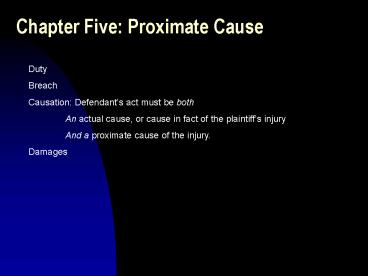Chapter Five: Proximate Cause PowerPoint PPT Presentation
1 / 11
Title: Chapter Five: Proximate Cause
1
Chapter Five Proximate Cause
Duty Breach Causation Defendants act must be
both An actual cause, or cause in fact of the
plaintiffs injury And a proximate cause of the
injury. Damages
2
Proximate Cause An Approach
- What category of cases does your case fall into?
- Unforeseen Harm
- Unforeseen Manner
- Unforeseen Plaintiff
- What rule -- doctrine -- applies to this
particular category? - Apply the rule you settle on to the facts you
have.
3
Proximate Cause An Approach
- Re 2 What are the doctrinal options?
- Defendant has a duty to this plaintiff, has been
negligent, and his negligence has in fact caused
harm. Should his liability extend - to the foreseeable results of his actions, and no
further? - 2) to all the results of his actions,
foreseeable or not? - 3) to some, but not all of the unforeseeable
consequences of his actions?
4
Unexpected Harm
1. Fact Pattern 1 the eggshell skull
plaintiff 2. Rule Liable for the full extent
of the harm, even if it is unforeseeable 3.
Application Characterize the defendants acts
as creating a foreseeable risk of physical
injury to this plaintiff, the extent of the harm
is then irrelevant
5
Unexpected Harm
- In Polemis, which characterizes the courts
approach - Defendant has been negligent, and his negligence
has in fact caused harm. Should his liability
extend - to the foreseeable results of his actions, and no
further? - 2) to all the results of his actions, foreseeable
or not? - 3) to some, but not all of the unforeseeable
consequences of his actions?
6
Unexpected Harm
- In Polemis, which characterizes the courts
approach - Defendant has been negligent, and his negligence
has in fact caused harm. Should his liability
extend - to the foreseeable results of his actions, and no
further? - 2) to all the results of his actions, foreseeable
or not? - 3) to some, but not all of the unforeseeable
consequences of his actions? - Polemis (all harm directly caused)
7
Unexpected Harm
- In Wagon Mound, which characterizes the courts
approach - Defendant has been negligent, and his negligence
has in fact caused harm. Should his liability
extend - to the foreseeable results of his actions, and no
further? - 2) to all the results of his actions, foreseeable
or not? - 3) to some, but not all of the unforeseeable
consequences of his actions?
8
Unexpected Harm
Does the defendants liability extend 1) only
to the foreseeable results of his actions, and no
further? Wagon Mound I 2) to all the results of
his actions, foreseeable or not? 3) to some, but
not all of the unforeseeable consequences of his
actions?
9
Unexpected Harm
Does the defendants liability extend 1) only
to the foreseeable results of his actions, and no
further? Wagon Mound I 2) to all the results of
his actions, foreseeable or not? Eggshell skull
rule 3) to some, but not all of the
unforeseeable consequences of his
actions? Polemis (all harm directly caused)
10
An approach
1. Fact Pattern 2 the unexpected harm 2. Rule
A division in authority Polemis all harm that
is directly caused Wagon Mound I liability
limited to what was foreseeable 3.
Application Under the WM approach
Characterize the foreseeable risk broadly, if you
are the plaintiff narrowly, if you are the
defendant. Under the Polemis approach Is the
causation direct.
11
Assignment
Tuesday 419-434 Problem Thursday 435-452
460-476

